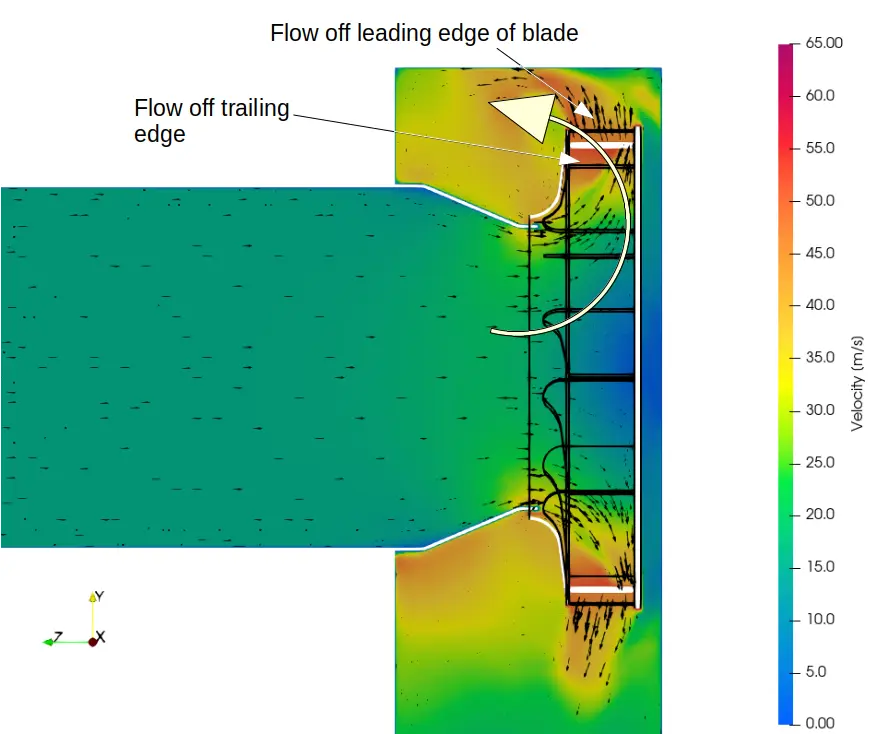
Introduction
To demonstrate SimSpire’s CFD capability, we have simulated a centrifugal fan that is typically used in industry. Fans are used extensively in HVAC and air pollution control. The fan geometry used in this simulation downloaded from GrabCad here and details that don't influence the flow such as bolts and external ribs and supports were removed. In this blog, we'll estimate the fan characteristics that would be found on the fan curve and we discuss some details of the flow field within the fan.CFD Setup
The operating conditions of this fan are not known and have been estimated. We can apply some engineering sense to provide a reasonable starting point for setting up the simulation. In this case, an inlet speed of 15 m/s in the pipe line is seems reasonable. This is a value experienced by SimSpire in dust handling applications. As a result, the following details have been used.| Property | Value |
|---|---|
| Property | Value |
| Fan diameter | 0,74 m |
| Inlet diameter | 0,55 m |
| Outlet dimensions | 0,6 x 0,4 m |
| Fan discharge height | 0,1 m |
| Inlet velocity | 15 m/s |
| Inlet flow rate | 12 852 m3/hr |
| Outlet pressure | 0 |
| Rotational speed | 1500 rpm |
| Resultant fan tip speed | 55 m/s (Mach 0.13) |
Due to the low tip speed, it is possible to simulate the fan with an incompressible solver. If the tip speed were to exceed Mach 0.2, then an compressible solver would be used.
Results
Fan curves are generated by a manufacturer and used to select the appropriate fan for a particular application. To produce a fan curve, requires multiple CFD runs for each chosen flow rate. In this blog, we have only chosen a single point to illustrate that it is possible to extract accurate results.
For the simulated operating condition, the flow rate, total pressure increase over the fan and the absorbed power are shown in the Table 2. The pressure difference is the pressure at the inlet subtracted from the pressure at the outlet. In Table 2, it is shown that the fan efficiency is 52%.
Fan efficiencies can go up to 82% for flat plate fans, so 52 % is somewhat low, but is in the right order of magnitude. Better results may be achieved if a reasonable flow rate is given or if the fan operates at 3000 rpm. 3000 rpm is not unreasonable given that the tip speed is only 55 m/s. Theoretically, the tip speed could be much closer to Mach 1.
The original model included a WEG 132 frame motor. This power of a 132 frame size motor ranges from 5.5 kW - 11 kW. The simulations result also appears reasonable that the calculated power of 8.24 kW falls in the range of potential motor powers.
| Property | Value |
|---|---|
| Result | Value |
| Pressure increase over the fan | 1200 Pa |
| Fan absorbed power | 8,24 kW |
| Efficiency | 52 % |
Flow pattern
The image shows the velocities generated by the fan. As expected, high velocities generated off the fan blades. The flow off the blades is distorted where the gab between the fan and the housing are smallest and most well developed where the gap between the fan and housing are largest.
The velocities reach a peak of 65 m/s. The velocity is essentially the sum of the inlet velocity and the fan tip speed.

Cross-section through the fan
A cross sectional view shown along the axis of rotation of the shaft is shown. In the image, the flow of the trailing and leading faces off the blade are shown. On the trailing face of blade, the velocity is not uniformly distributed as it is off the leading face.
From the view shown, SimSpire would investigate a fan redesign that leads to better distribution across the trailing face of the blade with the expectation that this could bring some efficiency improvement. Additional improvement could be obtained by reducing the size of the stagnation region at the the center of the fan, also shown in the cross sectional view. These investigations are much easier to do computationally than experimentally.
The large arrow shows the circulation generated in the blade of the cross-section. This circulation extends into the rest of the fan housing. Extensive vortices can be expected due to firstly, the rotation of the fan and secondly, due to the inlet flow been turned 90 degrees into radial flow. These vortices will continue into the fan housing and down the pipe/duct work until they diminish in size until they eventually dissipate into heat.

Conclusions
In this blog we have simulated a centrifugal fan and shown the estimated efficiency and power for the operating condition chosen. We have shown velocity fields through the cross-section and highlighted further investigations that SimSpire would perform to obtain some improvements. These investigations require multiple iterations to find improvement and this is most easily achieved computationally before finally testing experimentally.
If you have any questions, or would like to discuss how CFD could be of value to your process please contact us.